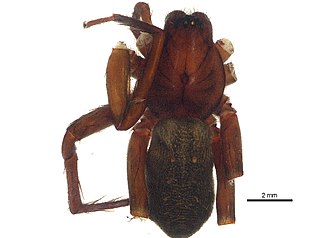Notnops is a monotypic genus of South American araneomorph spiders in the family Caponiidae, containing the single species, Notnops calderoni. It was first described by Norman I. Platnick in 1994, and has only been found in Chile. They have an orange carapace with yellow legs. Males have a body length of about 2 millimetres (0.079 in) long, and females are slightly larger, with a body length up to 3 millimetres (0.12 in).

Caponiidae is a family of ecribellate haplogyne spiders that are unusual in a number of ways. They differ from other spiders in lacking book lungs and having the posterior median spinnerets anteriorly displaced to form a transverse row with the anterior lateral spinnerets. Most species have only two eyes, which is also unusual among spiders. A few species of Caponiidae variously have four, six or eight eyes. In some species the number of eyes will increase when the spiderling changes its skin as it grows towards adulthood.

Cubanops is a genus of Caribbean araneomorph spiders in the family Caponiidae first described by A. Sánchez-Ruiz, Norman I. Platnick & N. Dupérré in 2010. These spiders are wandering hunters, generally found at ground level, under stones, in leaf litter or in the soil, and have only been found in the West Indies.

Nops is a genus of medium-sized South American, Central American, and Caribbean spiders in the family Caponiidae, first described by Alexander Macleay in 1839. It has a great richness on the Caribbean islands, and most mainland species are located in high proportion toward the Caribbean coast. It likely has a neotropical distribution, though most species of South America are known only from the coast of Colombia and Venezuela, including the islands of Aruba, Curaçao, Bonaire and Trinidad.
Inthaeron is a monotypic genus of Asian araneomorph spiders in the family Cithaeronidae, containing the single species, Inthaeron rossi. It was first described by Norman I. Platnick in 1991, and has only been found in India. Females can be distinguished from those of its sister genus, Cithaeron, by the arrangement of cylindrical gland spigots on the posterior median spinnerets, appearing in two rows rather than in clusters. The name is derived from "India", the country it was first found in, and "Cithaeron", the name of the other genus of Cithaeronidae.
Pseudanapis is a genus of araneomorph spiders in the family Anapidae, first described by Eugène Simon in 1905. It is a senior synonym of "Gossiblemma" and "Amrishoonops".
Caponina is a genus of araneomorph spiders in the family Caponiidae, first described by Eugène Simon in 1892.
Iraponia is a monotypic genus of Asian araneomorph spiders in the family Caponiidae, containing the single species, Iraponia scutata. It was first described by Y. Kranz-Baltensperger, Norman I. Platnick & N. Dupérré in 2009, and has only been found in Iran.

Laoponia is a genus of Southeast Asian araneomorph spiders in the family Caponiidae, first described by Norman I. Platnick & Peter Jäger in 2008. As of April 2019 it contains only two species.
Nopsides is a monotypic genus of North American araneomorph spiders in the family Caponiidae, containing the single species, Nopsides ceralbonus. It is one of three nopine species, in addition to Tarsonops and Orthonops, described by Ralph Vary Chamberlin from specimens collected from the Baja California region and nearby islands in 1924. They are active during the night, hiding under large stones of Mexico's deserts and xeric shrublands during the day.
Nyetnops is a genus of South American araneomorph spiders in the family Caponiidae, first described by Norman I. Platnick & A. A. Lise in 2007. As of April 2019 it contains only two species.
Orthonops is a genus of North American araneomorph spiders in the family Caponiidae, first described by R. V. Chamberlin in 1924.
Taintnops is a genus of South American araneomorph spiders in the family Caponiidae, first described by Norman I. Platnick in 1994. As of April 2019 it contains only two species, both found in Chile.
Tisentnops is a genus of South American araneomorph spiders in the family Caponiidae, first described by Norman I. Platnick in 1994. As of April 2019 it contains only three species.
Questo is a monotypic genus of Australian araneomorph spiders in the family Trachycosmidae containing the single species, Questo annuello, named after where it was found, Annuello, Victoria. It was first described by Norman I. Platnick in 2002, and has only been found in Australia.
Cubanopyllus is a monotypic genus of Caribbean ground spiders containing the single species, Cubanopyllus inconspicuus. It was first described by G. Alayón G. & Norman I. Platnick in 1993, and has only been found in Cuba.

Anachemmis is a genus of North American false wolf spiders that was first described by Ralph Vary Chamberlin in 1919. It was briefly synonymized with Titiotus, but was reconfirmed as its own distinct genus in 1999.

Socalchemmis is a genus of North American false wolf spiders that was first described by Norman I. Platnick & D. Ubick in 2001. The genus name comes from a shortening of the phrase "Southern Californian Chemmis", as the genus was discovered in California.
Nopsma is a genus of tropical spiders in the family Caponiidae. It was first described by A. Sánchez-Ruiz, Antônio Domingos Brescovit and A. B. Bonaldo in 2020. It was originally described under the name "Nyetnops juchuy" in 2014. They are found in Central and South America.





